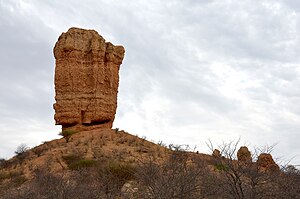Cliff (geology)
In tectonics, a cliff is the part of a tectonic cover (thrust cover ) that is completely separated from the main body of the cover by erosion and is therefore no longer in physical contact with it. Cliffs are tectonically higher ( hanging walls ) than the side rocks and are surrounded all around by tectonically lower lying rocks , the lying . In active mountains such as the Alps , cliffs are mainly found as peaks ( cliffs ) or high mountain ridges building units or in the core of synclines (hollows).
The myths in the Swiss Alps are a prime example of a tectonic cliff . On the eastern edge of the Alps, from the Austrian Weinviertel to South Moravia , there is a limestone cliff zone ( Leiser Berge , Staatzer Klippe , Falkensteiner Klippe , Pollauer Berge ), the highest elevation of which is the 554 m high Maidenberg in South Moravia.
The counterpart to the tectonic cliff is the tectonic window , the opening or gap in a thrust cover.
See also
literature
- GH Eisbacher: Introduction to Tectonics. Enke Verlag, Stuttgart 1996, ISBN 3-432-99252-1 .
- T. Labhart: Geology of Switzerland. Ott Verlag, Thun 2001, ISBN 3-7225-6762-9 .


